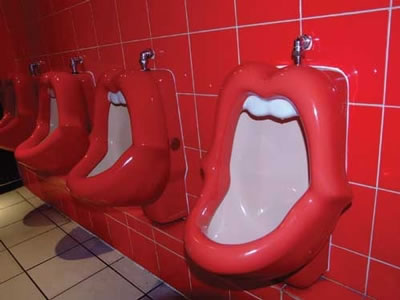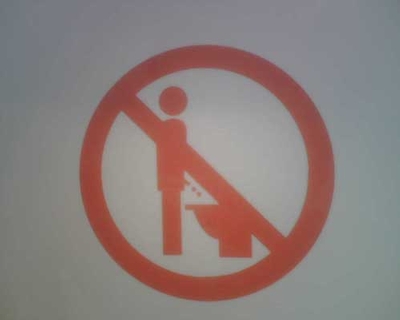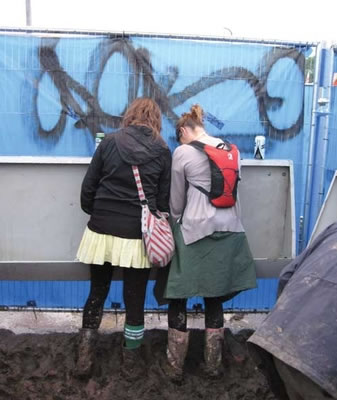 How would you fancy peeing into a shiny brass tuba – or splashing into the face of Saddam Hussein? Well, you can in America, which boasts some of the world’s most inventive toilets. And Europe’s catching up fast. In the UK there’s a urinal in the shape of a red-lipped open mouth, while in France there’s one held in place by two invitingly splayed legs. In Germany you can find a bowl with a football pitch and goal, complete with a strategically placed ball to aid accurate aiming. In Italy, your water can be made sacred by a line of Virgins awaiting your relief. And just in case you girls were feeling left out, there’s a treat waiting for you in Spain – washtaps in the shape of penises with testicles for tapheads.
How would you fancy peeing into a shiny brass tuba – or splashing into the face of Saddam Hussein? Well, you can in America, which boasts some of the world’s most inventive toilets. And Europe’s catching up fast. In the UK there’s a urinal in the shape of a red-lipped open mouth, while in France there’s one held in place by two invitingly splayed legs. In Germany you can find a bowl with a football pitch and goal, complete with a strategically placed ball to aid accurate aiming. In Italy, your water can be made sacred by a line of Virgins awaiting your relief. And just in case you girls were feeling left out, there’s a treat waiting for you in Spain – washtaps in the shape of penises with testicles for tapheads.
It’s sweet to find this homage to human waste manifested so creatively all over the world. But, sadly, it’s very rare. Most people in most places simply won’t be able to find a toilet when they need one. And for women, the lack of decent facilities is more than a problem. It’s an emergency. Public conveniences are the final battleground in the sex wars, the ultimate declaration of discrimination.
“Public toilets are among the last openly sex-segregated spaces that remain in our society and, crucially, among the last spaces that people expect to be sex-segregated,” declare Olga Gershenson and Barbara Penner, in the introduction to their recent collection Ladies and Gents: Public Toilets and Gender. Almost as the rallying cry of the book, they quote the African American legal scholar Taunya Lovell Banks: “We must realize that continuing inequality at the toilet reflects this male-dominated society’s hostility to our presence outside of the home.”
Gershenson and Penner quickly realised that one of the main barriers to open discussion and campaigning on this issue was that people find the whole subject offensive. As soon as they started the project and called for papers, “we ourselves became the subject of hundreds of sneering, baffling, and sometimes hilarious attacks with articles in newspapers entitled ‘How to earn your Pee h.D’ and ‘Academia goes down the toilet’. One shocked academic despaired: ‘Has Aristotelian philosophy now given way to scholarly discourses on toilet bowls, outhouse designs and architecture?’”
Similar taunts were levelled at Rose George as she went round the world investigating, and bravely sampling, sanitation and toilet provision for her recent book The Big Necessity: Adventures in the World of Human Waste. “Is this all some giant experiment to see if we have no sense of class or dignity?” was one typical response to her work. And when, in this month’s Vogue, Christa D’Souza comes out of the water closet to tackle the subject of shit head-on, she’s ridiculed by bloggers and fashionistas alike for even wondering why poo is the last taboo.
The Western sensibility recoils at any mention of toilets, bodily waste, noxious smells and inelegant noises, which probably explains our obsession with scatological humour. The smallest child will laugh at a fart, everyone loves a whoopee cushion and the plethora of joke names for the lavatory, or the john, or the loo, or the bog, or the smallest room, or the washroom, or the WC or the powder room, all point to our extreme discomfort at this most basic of human functions.
And our collective reluctance to discuss the subject openly masks a massive global problem. According to Rose George, 2.6 billion people are without sanitation at all – not even a public toilet or a rudimentary outhouse. This lack of proper amenities results in widespread disease and, very often, death. “Poor sanitation, bad hygiene and unsafe water – usually unsafe because it has faecal particles in it – cause one in ten of the world’s illnesses. Children suffer most. Diarrheoa – nearly ninety per cent of which is caused by faecally contaminated food or water – kills a child every fifteen seconds.”
But the crisis is a relatively recent one. Traditionally, rural communities would dispose of their waste in the fields or, as communities developed, in collective public latrines – still used in the developing world, especially in countries where water is in short supply. But even in Neolithic times, according to Virginia Smith, author of Clean: A History of Personal Hygiene and Purity, there would be highly organised systems of latrines down which the solids dropped and the water flowed, with a receptacle or pit to collect the final waste. The Romans created magnificent underground sewers flowing down to the Tiber. And European grand palaces during the Renaissance had introduced elaborate plumbing systems including luxury bathrooms and latrines. At Hampton Court, Smith relates, “Henry VIII built the Great House of Easement, a four-tier, twenty-eight-seater communal latrine block set over the west arm of the moat.”
The trouble with all of these systems, of course, was that however charming the architecture, the waste still flowed into natural waterways which became increasingly contaminated. And it was not until the nineteenth century that it began to be recognised that filthy, soiled water carried disease – from the lethal germs emanating from human waste. New approaches to sanitation and public amenities went hand in hand with the development of the industrialised centres of Europe – so much so that the sociologist Norbert Elias, in The Civilizing Process, argues that the rise of civility can be traced to the increasing control over bodily excreta. The more civilised the country the better its public conveniences should be. Which means that Japan must be at the top of any civilisation league table. That nation’s toilets feature a bottomless array of gadgets: slam lids, heated seats, fragrant scents, massaging jets of water followed by a blow dry. One model will electrically measure the body fat in your rear; another will analyse your waste products or monitor your menstrual cycle.
And by the same measure, the United States is still in the Dark Ages. You may think of America as the country that created the allergy, where bathroom culture rules, where germs and dirt are feared more than global warming and where cleanliness is worshipped alongside godliness – but public conveniences in some of its major cities are a disgrace. New York City, for example, is one of the most sophisticated metropolises in the world. Yet its provision of any public toilets at all, let alone clean and decent ones, is woeful.
 “Three successive mayors failed to agree proposals that would have put public restrooms on New York’s streets,” writes Rose George. “When Michael Bloomberg did, in 2005, newspaper headlines cheered that new restrooms were finally going to be provided. On closer inspection, it was apparent that the plan would provide 3300 bus shelters, 330 new kiosks and only 20 public toilets.”
“Three successive mayors failed to agree proposals that would have put public restrooms on New York’s streets,” writes Rose George. “When Michael Bloomberg did, in 2005, newspaper headlines cheered that new restrooms were finally going to be provided. On closer inspection, it was apparent that the plan would provide 3300 bus shelters, 330 new kiosks and only 20 public toilets.”
The great toilet divide, like so much else in the land of liberty, comes down to money and class. Indeed, provision of toilets is an acute barometer of a culture’s equality. So, for example, during apartheid in South Africa, access to toilets was designated by race. “White settlements, even poor ones, usually got flush toilets and waterborne sewerage. Blacks had bucket latrines – a bucket with a seat on top – or nothing. By the time democracy came to South Africa in 1994, a relatively rich country had, for reasons of racism and politics, desperate sanitation figures comparable with those of poorer African countries with fewer resources.”
And wherever you go, whatever measure you choose, it’s women who are always at the bottom of the pile. Across Africa, school toilets are frequently so bad that girls will refuse to go to school when they have periods. In India, the untouchables have traditionally been given the task of picking up excrement, often with bare hands, and carrying it to the nearest dump. Even though the caste system is meant to be outlawed the Dalit are still there in many villages, still carrying away the faeces of their employers, and it’s mostly the women charged with the task.
All over the world, it tends to fall to women to clean, to get rid of waste, to work as toilet attendants: and it’s women who suffer most when lavatories are in poor supply. If you’re travelling anywhere in China or India, just forget about finding any form of toilet for women at all. The difference between a woman and a camel, goes the well-worn travellers’ joke, is that a camel can go all day without drinking, while a woman can drink all day without going.
Back in the UK, the number of public conveniences has decreased considerably over the past decades, and especially those for women. In a House of Commons debate last year, Dr Phyllis Starkey made the point that, while the decline in provision of public toilets was deplorable, it particularly affected certain disadvantaged groups: the elderly, disabled people, those with young children and, of course, women who, she reminded us, “have an additional need to gain access to high-quality, clean public conveniences during certain periods in their lives.” In her contribution to the Ladies and Gents collection, Clara Greed explains further why women are particularly in need of public toilets, “as they are the ones most frequently out and about in the daytime, travel on public transport more than men, and often are accompanied by children or elderly or disabled relatives.”
Rose George agrees. “Careful research has established that women take 90 seconds to urinate, while men take 45,” she points out. “Men who complain that women should hurry the hell up do not take into consideration the fact that women have to undress and sit. They have cumbersome clothes. They have shopping bags sometimes, and small children.”
Dr Starkey had been a member of the House of Commons Communities and Local Government Committee whose report on The Provision of Public Toilets, published in October 2008, concluded that the steady decline in the provision of public toilets in recent years needs to be addressed. Now, she was arguing for a consistent policy requiring local authorities to make public conveniences available. And her concerns are hardly new. Although public conveniences began to be introduced in the UK as far back as the 1820s – and their installation at the Great Exhibition in 1851 was greeted with such heartfelt enthusiasm – it wasn’t until the 1860s that the first female toilets were provided. “Either ladies didn’t go out or ladies didn’t go,” remarks Erika Rappaport in Shopping for Pleasure: Women in the Making of London’s West End. She hails the establishment of the big department stores as a landmark for women’s liberation. They may have offered ladies, conveniences as a commercially shrewd move, but this simple provision allowed for the first time unprecedented freedom of movement for women. In response, the Ladies’ Sanitary Association was formed in the 1880s to campaign for the establishment of women’s conveniences at high-traffic spots.
In response to the campaign the local government planned to build a women’s lavatory at a busy junction in Camden Town. But they had to abandon plans after strenuous objections from residents worried that it might reduce their property values. But the underlying reason, suggests Barbara Penner, was that “sanctioning the women’s lavatory effectively sanctioned the female presence in the streets, thus violating middle-class decorum and ideals of women as static and domestic.”
Today, there are still far fewer public toilets for women than for men in many British cities, in terms of both the number of toilets available and the ratio of male to female facilities. But even if the numbers were more equal, that wouldn’t solve the problem, according to the American sociologist Harvey Molotch, because women suffer “special burdens of physical discomfort, social disadvantage, psychological anxiety” when in public.
A familiar example of this kind of frustration is the appalling facilities for women in most West End theatres. Jeanie Linders, author of Menopause the Musical, refused to allow the show to be staged in the West End for this very reason. Menopausal women, she reasoned, a large proportion of the expected audience, need to go when they need to go.
So what is needed, Molotch argues, is “an asymmetric distribution of space” in order to provide genuinely equal opportunity. And his view is shared by the veteran campaigner John Banzhaf, the American lawyer who made his reputation by founding the anti-tobacco lobby group Action against Smoking and Health. One of his more audacious moves was to file a complaint with the Capitol itself, claiming that “the failure of the House to provide . . . equivalent access for women constitutes illegal sex discrimination and violates the constitutional right of Equal protection.” He highlighted evidence that male members of Congress have access to a nearby toilet with “six stalls, four urinals, gilt mirrors, a shoeshine, ceiling fan, drinking fountain and television,” while the seventy female members needing the toilet would have to cross a public hall and pass open-plan offices and punch in a keypad code to ensure restricted access.
 But while these measures could offer real gains for women, they do pose another problem. And that is, they fail to challenge the assumption that women need separate facilities in the first place. “One is not born, but becomes a woman,” Simone de Beauvoir famously declared in The Second Sex. “No biological, psychical or economic destiny defines the figure that the human female takes on in society; it is civilization as a whole that elaborates this intermediary product betweenthe male and the eunuch that is called female.” The psychoanalyst Jacques Lacan also views set differences between the genders as illusory rather than inevitable. He sees the universal signs for men’s and women’s lavatories, backed up by the “laws of urinary segregation”, as the perfect illustration of the arbitrary construction of differences.
But while these measures could offer real gains for women, they do pose another problem. And that is, they fail to challenge the assumption that women need separate facilities in the first place. “One is not born, but becomes a woman,” Simone de Beauvoir famously declared in The Second Sex. “No biological, psychical or economic destiny defines the figure that the human female takes on in society; it is civilization as a whole that elaborates this intermediary product betweenthe male and the eunuch that is called female.” The psychoanalyst Jacques Lacan also views set differences between the genders as illusory rather than inevitable. He sees the universal signs for men’s and women’s lavatories, backed up by the “laws of urinary segregation”, as the perfect illustration of the arbitrary construction of differences.
And that “urinary segregation” begins at the point when little girls and boys are taught the “correct” way to pee. Freud may have regarded toilet training as a vital staging post in the developmental process, but for Simone de Beauvoir this very process marks the decline into sexual oppression, when girls are taught to crouch in a subordinate position while boys are encouraged to stand proud.
There’s no absolute biological rule for this distinction. Boys may be able to produce the perfect arc when urinating, but that doesn’t make them superior. Indeed, according to Rose George, they don’t do it that way in Germany since they consider it unhygienic, probably because so many men appear to have trouble with accurate aim, with resultant splashing outside the bowl. You can even buy a ten-dollar German-made alarm that you attach to a toilet seat. When the seat is lifted, the transgressor is admonished that “stand-peeing is not allowed.”
Nonetheless, standing up to pee does have its advantages – the main one being speed. So surely if women were given the means to do it, they would at last be liberated from long queues, inadequate toilets and sex differences? This was the reasoning behind a radical innovation at the Glastonbury Festival in 2004. The She-Pee was a pink, fenced-off enclosure containing urinals for women. “Once past the guarded entrance,” relates Barbara Penner, “female users were supplied with a P-Mate, effectively a disposable prosthetic penis made of cardboard that enabled them to stand up to pee.”
The reception, according to Penner, was rapturous. The She-Pees were cleaner, there were no queues, they were more hygienic. P-mate is now just one of several devices that are cheap and available and represent a simple alternative to the age-old problems of queues and scarcity.
 But not everyone would agree. Female urinals may be offered as a solution to restroom congestion, remarks Rose George, but “they are usually offered as a solution by men who won’t have to use them.” And one commentator who is enraged by the very idea of them is Clara Greed. She hates female urinals because the concept is short-sighted. “Women would not take as long if their public toilets were better designed. There would be fewer queues if there were more public toilets.”
But not everyone would agree. Female urinals may be offered as a solution to restroom congestion, remarks Rose George, but “they are usually offered as a solution by men who won’t have to use them.” And one commentator who is enraged by the very idea of them is Clara Greed. She hates female urinals because the concept is short-sighted. “Women would not take as long if their public toilets were better designed. There would be fewer queues if there were more public toilets.”
Nor would urinals be much of a solution for women wearing layers of clothing, or carrying shopping, or menstruating. And apart from the various impracticalities of female urinals there’s the question of privacy. Since communal changing rooms never really caught on, it’s hard to imagine communal loos being that popular, even though the modern concept of privacy is a fairly recent one. “As Norbert Elias wrote in The Civilizing Process,” writes Rose George, “it’s only slowly and without much forethought that humans in industrialised societies have developed the pressing need to perform certain functions away from the gaze of other people.”
And of those “certain functions” the business of doing one’s business comes right at the top in the privacy stakes. Mary Douglas, in her groundbreaking analysis Purity and Danger, showed how social and tribal taboos, the ways in which the notion of dirt is managed in different communities, are means of regulation and control. It’s not the nature of the filth that matters so much as the need for distinctions and separations which hold societies together. Which is why religious purity rules and prohibitions tend to be concerned far more with the rules and transgressions of those rules than with any physical repercussions of breaking them.
Douglas’s recognition of “pollution fear” does explain in part our revulsion at the notion of bodily waste. And our assumption that women need separate spaces to perform a somewhat different function from men may well be bound up in traditional notions of sex differences.
“To perform a private function in a public setting requires what the American sociologist Erving Goffman called ‘civil inattention’, or the art of making living among unknown people tolerable,” writes George. “You know they’re there, but you pretend not to acknowledge them, by whatever means are at your disposal. How many people have lingered in a cubicle so that the sound of their excretion – of whatever variety – can’t be associated with them when they come out? How many have cringed in a hotel bathroom too close for comfort to a bedroom containing a new lover?”
And that, for me, is the final and most compelling argument. Women, whatever their chosen version of feminism, do like to retain their mystery. They perfectly understand this in Japan, where you can install in your loo a device called a Sound Princess – an electronic gadget which makes the sound of constant flushing to obscure more earthy lavatorial noises.
Marilyn Monroe could have done with one of these when Arthur Miller took her to meet his mother just after they were engaged. All went well until Marilyn had to go to the toilet. Because it was right next to the living room, with a flimsy door and very thin walls, she turned on all the taps so that she couldn’t be heard. Next day, Arthur calls the mother and says, “How did you like her?” And the mother says, “She’s sweet, a wonderful, wonderful, wonderful girl, but she pisses like a horse!”

